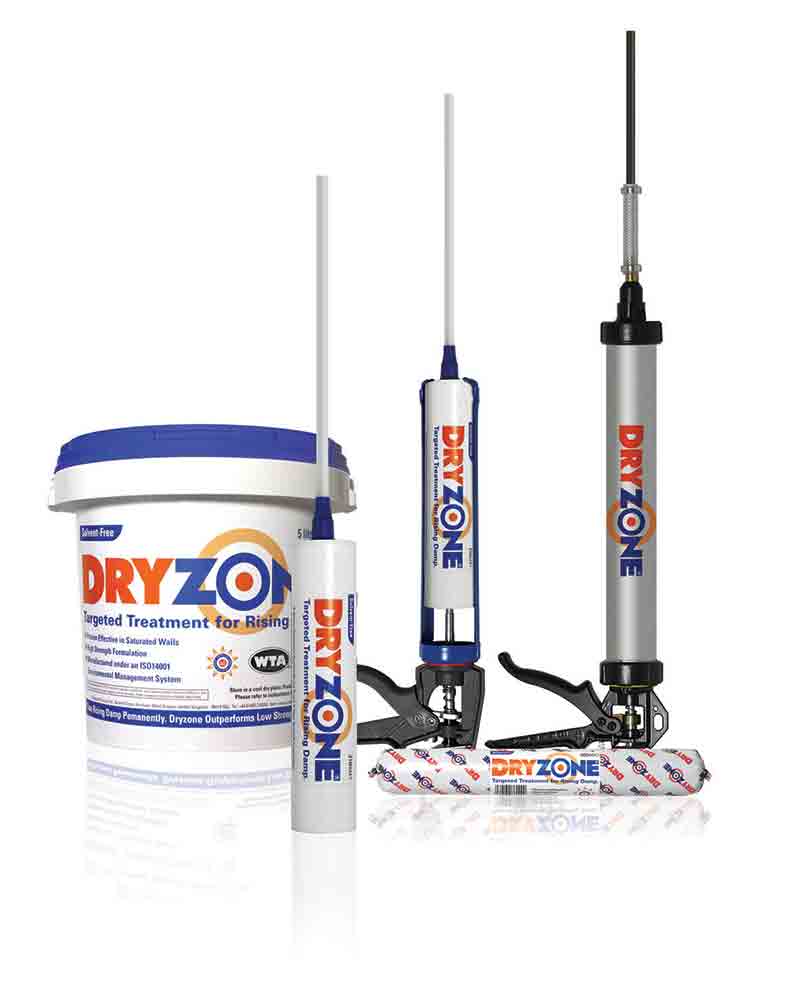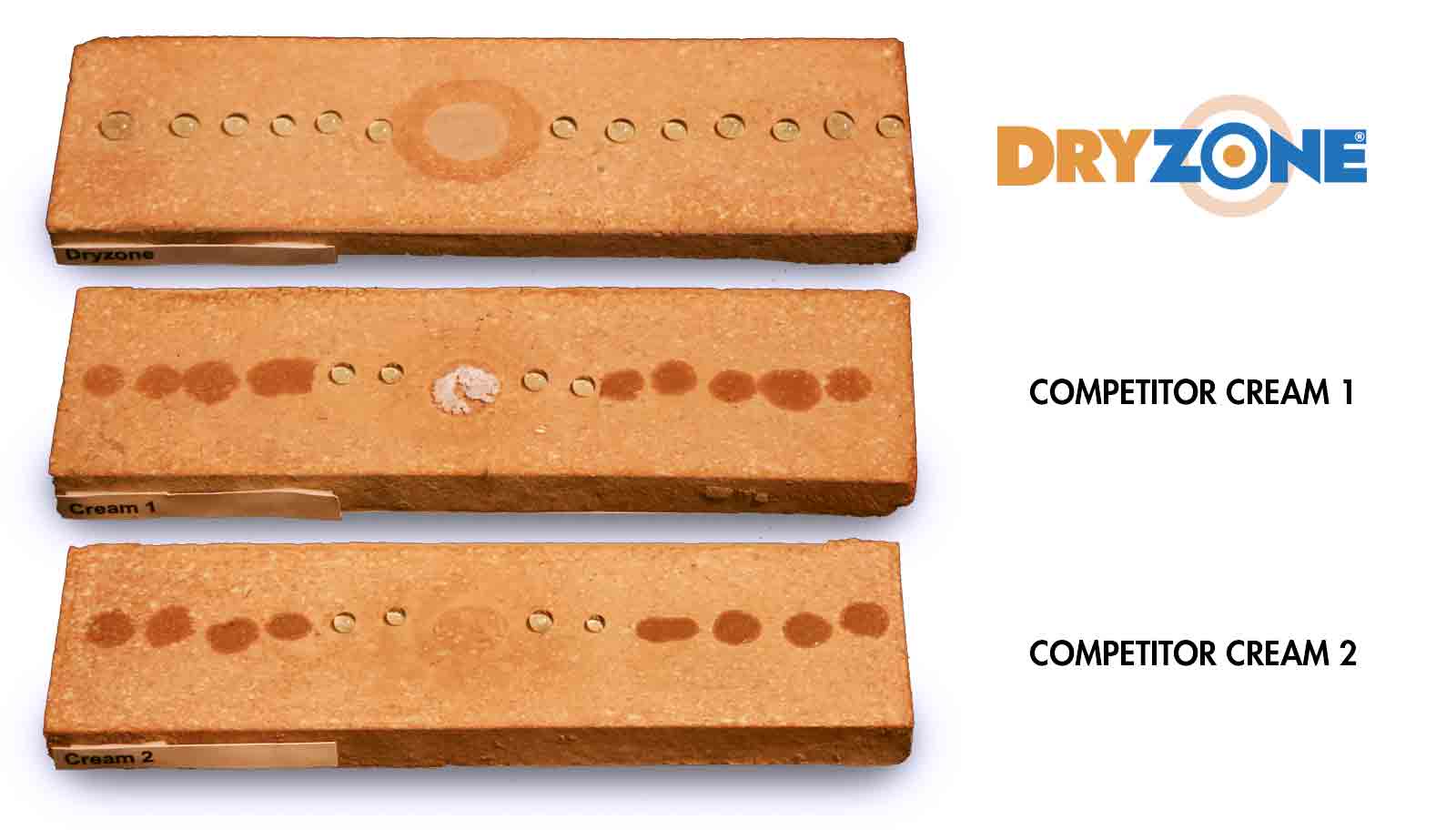The Development of Dryzone damp-proofing cream
Dryzone is a special damp-proofing cream that is introduced along the mortar course at regular intervals by injecting it into pre-drilled holes. The Dryzone then diffuses before curing to form a continuous water-repellent barrier. This prevents the damp from rising up the wall. Since the 1950s, liquid chemical injection systems, which work in a similar way have been used to treat rising damp with a high degree of success.

Technologists at Safeguard realised that a concentrated “cream” formulation would overcome many of the problems associated with traditional damp-proofing systems. Ideally, such a system would not have to be injected at high pressure into the wall and would be able to deliver the correct level of active ingredient into the wall in a single pass. However, to offer a true breakthrough in rising damp treatment, it would have to meet some challenging design criteria:
- Water-based
- Stable formulation
- Low toxicity
- Equal or better performance than pressure injection
- Minimal staining
- Quick and easy to apply
- Odourless
- Effective in a wide range of substrates
- High level of active ingredient
Over one-hundred formulations were screened for performance using the “brickburger” test shown below:

These “brickburgers” consisted of a layer of mortar sandwiched between two clay brick slips. The mortar used was a formulation originally developed by the Building Research Establishment to emulate 100-year old lime mortar. Test formulations were introduced into a 12mm hole formed in the mortar and then placed on a bed of wet vermiculite in a test tank. The “brickburgers” were then periodically weighed gravimetrically to obtain water uptake data.
Formulations that performed well were subjected to accelerated aging tests by storing them at 30°C in an incubator. After stability testing, the final formulation was tested against a conventional chemical damp-proofing treatment in the larger scale “brick pillar” test pictured below:

Active rising damp was established by submerging the bottom of the pillars in water to a depth of 25mm for a period of three weeks. At this point two of the pillars were treated with Dryzone and another two were treated using a conventional chemical treatment. A further two pillars were left untreated as controls. The pillars were kept wet for a further three weeks before being allowed to dry out for 9-months. Water was then re-introduced to the bottom of the pillars and measurements were taken to establish water uptake following treatment. The lower the water uptake, the better the formulation is at controlling rising damp.

As can be seen from the graph above, Dryzone exceeded one of its main design criteria by outperforming the conventional treatment (Siliconate) that it was designed to replace.
In fact the final Dryzone formulation met or exceeded all of the design criteria that were set at the concept stage.
To date over 2 million tubes of Dryzone have been sold, enough to successfully treat rising damp in over 13 million metres of four and a half inch wall.
Proven quality
BBA certificate

Independent confirmation of the effectiveness of Dryzone came in May 2002 when Dryzone became the first damp-proofing cream to receive BBA Certification
The complete Safeguard damp-proofing systems Agrément certificate. Dryzone is dealt with on pages 21 and 22 (detail sheet 5). For details about BBA certification, visit the BBA website.
Comparison with Competing Products
The success of Dryzone inevitably produced a plethora of look-alike products. However, because Dryzone is protected by patent, none of these products can benefit from Dryzone’s unique formulation technology.
Performance
In-house and independent tests demonstrate that Dryzone is considerably more effective than look-alike products at controlling rising damp. This is not surprising when you consider that Dryzone contains over 60% active ingredient (active silicones) whereas many look-alike products contain as little as 10% active ingredient.
These low levels of active ingredient are even more apparent when shown in the context of the amount of active ingredient introduced into each linear metre of wall:

As the graph above shows, Dryzone’s active ingredient level is high enough to introduce as much active ingredient into the wall as the traditional liquid damp-proofing fluids which have been used since the 1950s. The amount of active ingredient introduced by the look-alike 10% cream is tiny by comparison.
Furthermore, Dryzone’s unique formulation causes these active ingredients to spread further in the wall – providing a more even and complete rising damp treatment. The difference between the spread characteristics of Dryzone and look-alike products can be illustrated using a simple spread test:

In the example shown above, a 2ml sample of each of the damp-proofing creams to be tested was placed in the centre of a damp clay brick slip and left for a period of four weeks. After this period, a water dropper was used to place droplets of water on the brick slips. As can be seen, the Dryzone has spread to damp-proof the whole brick slip while the look-alike creams have only spread a few centimetres.
The reputation of any damp-proofing company ultimately depends on the quality of work that it carries out. Using a higher-performance product such as Dryzone enables damp-proofing companies to maintain their reputation whilst reducing costs by keeping call-backs to a minimum.

